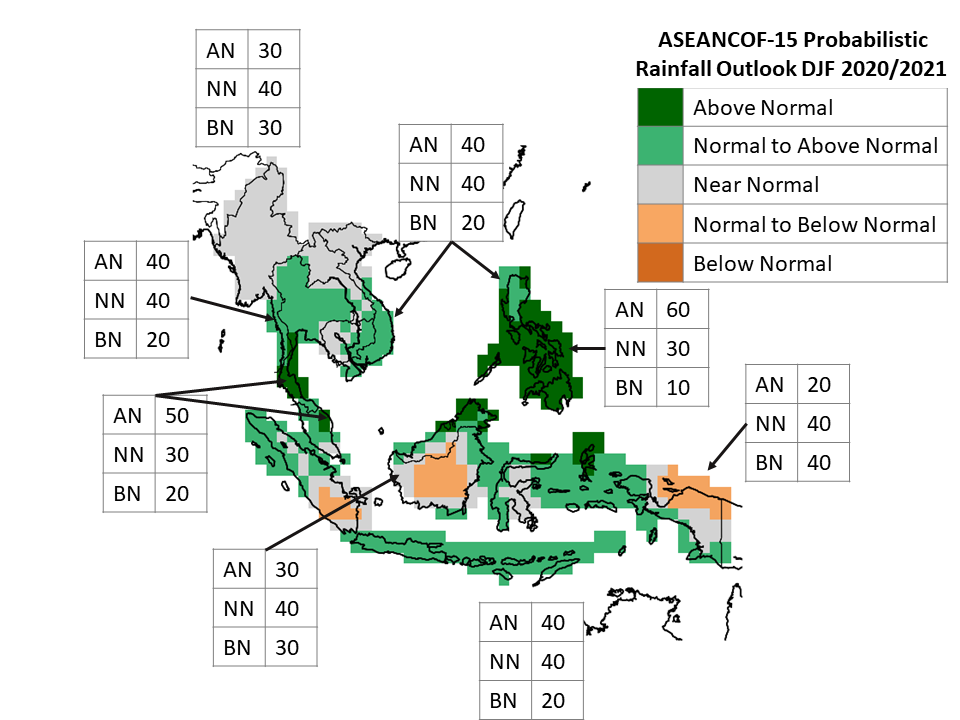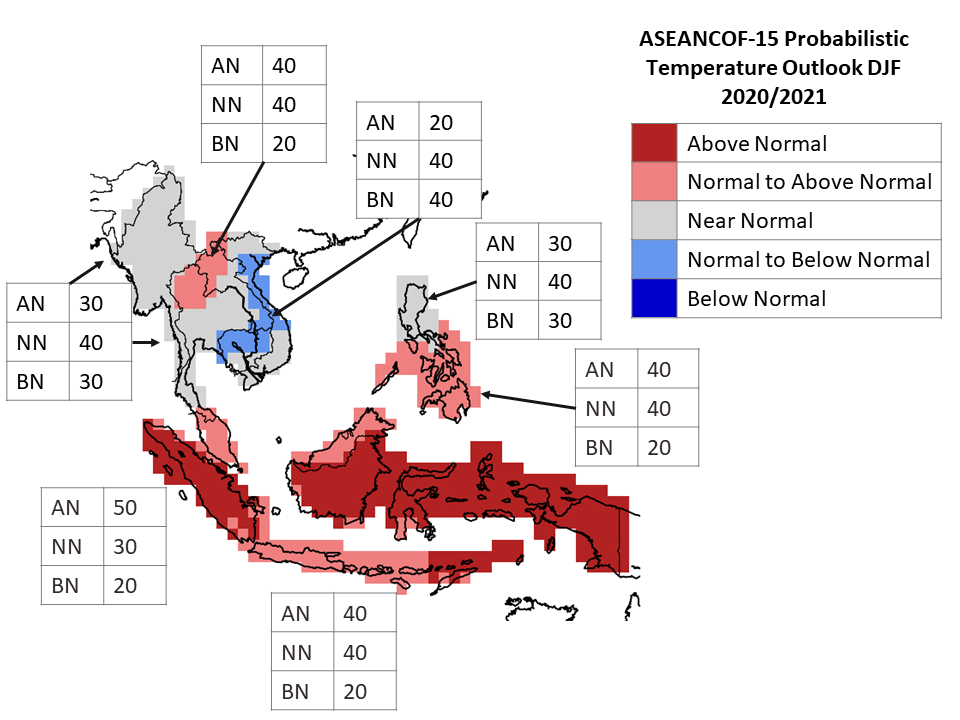07 DEC 2020
ASEAN Climate Outlook Forum
Fifteenth Session of the ASEAN Climate Outlook Forum (ASEANCOF-15)
23rd, 25th, 27th November 2020, Online
Consensus Bulletin for December-January-February (DJF) 2020/2021 Season
The ASEAN Climate Outlook Forum (ASEANCOF) is an avenue to collaboratively develop consensus-based seasonal climate outlooks and related information on a regional scale.
The forum outlook and its activities contribute significantly to one of the key roles of the ASEAN Specialised Meteorological Centre (ASMC), which is to conduct climate and seasonal prediction for the ASEAN region through pooling the expertise of ASEAN National Meteorological Services.
The fifteenth ASEANCOF (ASEANCOF-15) was organised by the ASEAN Specialised Meteorological Centre. Representatives from National Meteorological and Hydrological Services (NMHSs) of ASEAN Member States created a consensus forecast for the summer monsoon 2020 in the ASEAN region. The consensus for June-July-August (JJA) 2020 outlooks was achieved through online correspondence, including questionnaires and online discussions regarding the current conditions and predictions for the Southeast Asia region. In particular, the forum considered the possible influence of the El Niño Southern Oscillation (ENSO) and the Indian Ocean Dipole (IOD) on the climate system over Southeast Asia.

Conditions and Outlook
Recent analysis of sea surface temperature (SST) anomalies over the equatorial Pacific indicated below average SSTs across most of the central and eastern tropical Pacific Ocean and that La Niña conditions are present. The international climate outlooks predict La Niña conditions are very likely to continue during DJF 2020/2021. The La Niña conditions are expected to be moderate to strong during this time. La Niña conditions are expected to weaken during the boreal (Northern Hemisphere) spring.
The current Indian Ocean Dipole (IOD) state is neutral and is expected to remain neutral for DJF 2020/2021. The Northeast (NE) Monsoon is expected to be stronger than normal, based on model predictions and supported by the current La Niña conditions. For most countries, the onset of the NE monsoon is expected to be near-normal, or slightly earlier. Overall, the tropical cyclone frequency is expected to be above average for the Bay of Bengal, South China Sea and around the Philippine Sea. This is based on model predictions as well as during La Niña events there tends to be more tropical cyclones than average for the region.
Taking into consideration the national level forecasts, the present state of the climate, and the forecasts available from the GPCs and other global centres, the forum agreed on the following consensus-based outlook for DJF 2020/2021 for the Southeast Asia region:
RAINFALL
For the upcoming boreal (Northern Hemisphere) winter season (December- January- February 2020/2021), near-normal to above-normal rainfall is expected over much of the region (Brunei Darussalam, Malaysia, the Philippines, Singapore, Thailand, and southern parts of Myanmar and Viet Nam). The highest probabilities of above-normal rainfall are over Brunei Darussalam, southern Thailand, and parts of Malaysia and the Philippines. Elsewhere, near-normal or a range of below-normal to above-normal rainfall is predicted.
TEMPERATURE
For the southern half of Southeast Asia near-normal to above-normal temperature is predicted, including Brunei Darussalam, Malaysia, Singapore, and the southern half of the Philippines. In the northern half of Southeast Asia, near-normal to below-normal temperature is expected for parts of Lao PDR and Viet Nam. An increased chance of above-normal temperature is expected over northern Thailand and northern Lao PDR. Elsewhere, near-normal temperature is expected, particularly over most of Thailand, Myanmar and northern Philippines. On top of these temperature outlook, there may be increased chance of cold surges due to the stronger Northeast Monsoon predicted for the coming December-January-February 2020/2021 season.
Refer to Annex A for reference on what is meant by “above, near, or below normal” in the outlook. For more information on the Northern Hemisphere Summer Monsoon outlook and further updates on the national scale, the relevant NMHSs should be consulted (see Annex B).
Consensus Maps for DJF 2020/2021 Season
The following maps provide the probabilistic outlooks for DJF 2020/2021 season in terms of tercile categories of “Above Normal” (AN: upper tercile), “Near Normal (NN: middle tercile) and “Below Normal” (BN: lower tercile).
PROBABILISTIC RAINFALL OUTLOOK

PROBABILISTIC TEMPERATURE OUTLOOK

Acknowledgements
The Forum would like to convey its appreciation to the National Meteorological Services of the ASEAN Member States for sharing their national-level forecasts, the Global Producing Centres and other participating international and regional centres for sharing their products and expertise, and WMO for their continued support of ASEANCOF. The Forum would also like to thank the participants from the disaster risk reduction sector who attended the final day of the forum, sharing valuable insights into how to make seasonal outlooks more useful in the ASEAN region.
Back